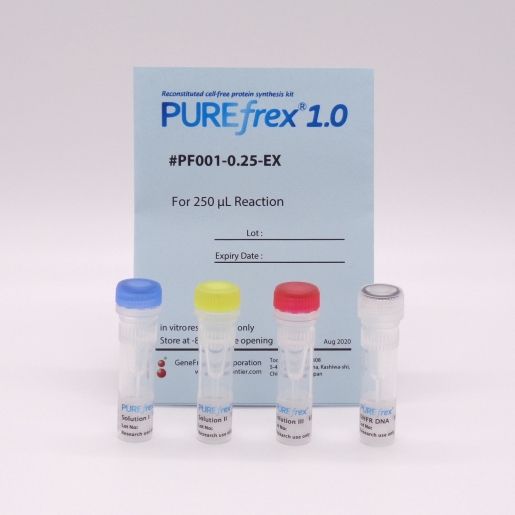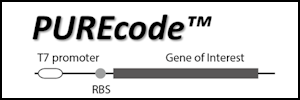[Information]
- [PUREcode] Consultation is free of charge! DNA Design for PUREfrex®
- [Important] Notice of Material and Preparation Method Change
- Exciting New Release! 50 mL Scale PUREfrex® Kits
CONTENTS
Overview
PUREfrex® kit is a reconstituted in vitro Coupled Transcription/Translation Systems, completely different from an E.coli extract S30 system.
PUREfrex® is a series of newly developed reconstituted cell-free protein synthesis reagent based on PURE (Protein synthesis Using Recombinant Elements) system technology invented by Professor Takuya Ueda in the University of Tokyo.
PUREfrex® 1.0 is the kit for basic research.
The productivity is lower and than PUREfrex® 2.0.
Dihydrofolate reductase (DHFR) from E.coli can be synthesized at approximately 160 µg per mL of PUREfrex® 1.0 reaction and approximately 600 µg per mL of PUREfrex® 2.0 reaction.
Disclosure of Component Information
The component information of PUREfrex® 1.0 is disclosed.
You may designed customize kits based on PUREfrex® 1.0.
Lower Contamination
By improving the purification process of components of PUREfrex®, contamination of RNase and β-galactosidase are greatly reduced, in addition to that, lipopolysaccharide (LPS) is also reduced to less than 1 EU per 1 µL of reaction mixture. All proteinous components of PUREfrex® have no tags for purification and detection. It allows to fuse your protein with any tag to purify the product.
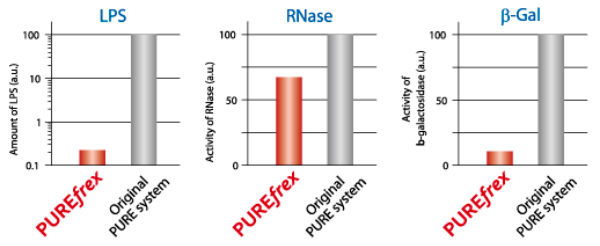
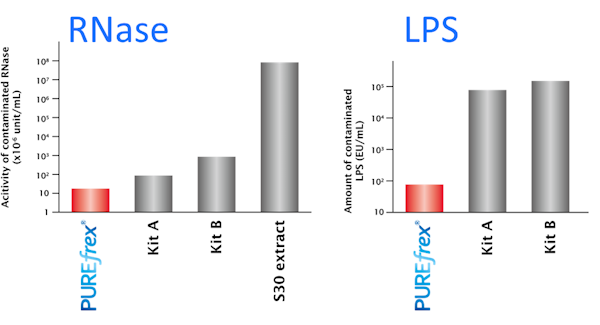
Comparison of PUREfrex with the original PURE system and commercial kits
Specifications
Kit components <PUREfrex® 1.0>
| Reagent | Quantity for 250 μL rxn |
Quantity for 2 mL x 5 rxn |
Description | Storage *1 |
|---|---|---|---|---|
| Solution Ⅰ | 125 μL | 1000 μL x 5 | Amino acids, NTPs, tRNAs and substrates for enzymes etc. | -20 °C |
| Solution Ⅱ | 12.5 μL | 100 μL x 5 | Proteins in 30 % glycerol buffer | -20 °C or -80 °C*2 |
| Solution Ⅲ | 12.5 μL | 100 μL x 5 | Ribosome (20 μM) | -80 °C*2 |
| DHFR DNA *3 | 10 μL | 10 μL x 1 | PCR product containing a gene encoding dihydrofolate reductase (DHFR) from E.coli as a positive control. (20 ng/μL) | -20 °C |
- Indicated temperature shows storage temperature after opening the kit. Please store the kit at -80 °C before opening.
- The rest of solution should be frozen rapidly in liquid nitrogen or dry ice/ethanol, and be stored at -80 °C. Divide into aliquots, if necessary, and avoid refreeze and thaw as much as possible.
- For synthesizing DHFR, add 1 µL of DHFR DNA to 20 µL of reaction. Sequence of DHFR DNA is here.
How to aliquot
PUREfrex® kits are highly stable during storage at -80°C. However, repeated freeze-thaw cycles can lead to a reduction in activity. If only small amounts are required per use, we recommend aliquoting the product into smaller portions for storage. When aliquoting small volumes, using low-binding tubes is advisable to minimize loss and ensure reliability.
[Solution I]
Thaw the solution by incubating it at room temperature or 37°C for approximately 5 minutes and mix thoroughly until it becomes completely clear. Aliquot the solution without placing it on ice and freeze the aliquots at -20°C or below.
[Solution II]
Thaw the solution on ice and mix thoroughly (for small volumes, gentle vortexing is acceptable as long as it does not create bubbles). Aliquot the solution and rapidly freeze the aliquots using liquid nitrogen or a freezing mixture of dry ice and ethanol. Finally, store them at -20°C or below.
[Solution III]
Thaw the solution on ice, avoiding extended exposure to the thawed state. Mix thoroughly, aliquot the solution, and rapidly freeze using liquid nitrogen or a freezing mixture of dry ice and ethanol. Store the aliquots at -80°C. Avoid freezing directly in a -80°C freezer without rapid freezing, as this can result in decreased activity.
Note
PUREfrex® is developed for in vitro research only. PUREfrex® should not be used for the therapy, diagnostic or administration to animals including human and should not be used as food or cosmetics etc. To avoid the contamination of nuclease, nuclease-free-treated water, reagents and materials should be used. We also recommend wearing gloves and mask.
“PUREfrex® is Registered in U.S. Patent and Trademark Office”
Experiment Workflow
General procedures for using PUREfrex® to synthesize functional proteins are shown in Figure.
Start by preparing the template DNA suitable to the protein synthesis with PUREfrex® and examine whether the protein of interest is synthesized. Redesign the nucleotide sequence of the template DNA if too little protein is synthesized. Add supplement such as molecular chaperones or changing the synthesis conditions if the solubility or activity of the synthesized protein is low or absent. The kit contains enough reagents for examining whether the target protein can be synthesized.
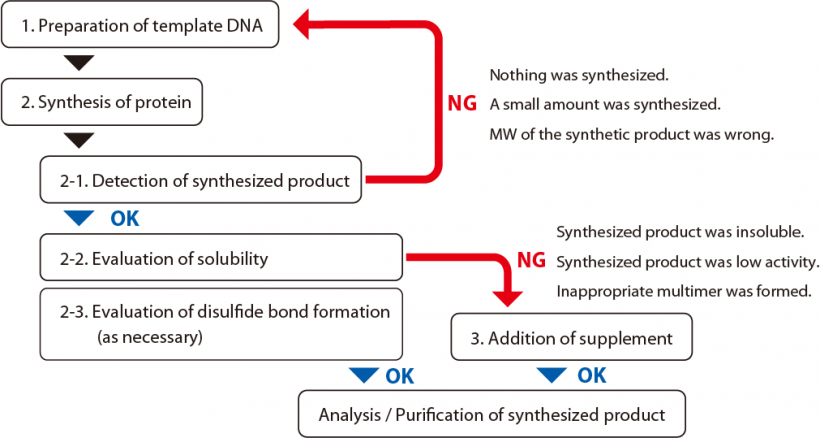
Protocols
The amounts given are for 20 µL reaction. For scaling up the reaction, adjust the volume of reagents accordingly.
1. Thaw Solution I by incubation at room temperature or 37 °C for 5 minutes for completely dissolving, and then leave at room temperature.
2. Thaw Solution II and III on ice.
3. Mix Solution I, II and III respectively by vortex and centrifuge briefly to collect each solution at the bottom.
4. Assemble the reaction mixture in a tube as follows. Add the template DNA to 1 – 3 ng/µL per 1 kb.
| Water | 8-X μL |
| Solution I | 10 µL |
| Solution II | 1 μL |
| Solution III | 1 μL |
| Template DNA *1 | X μL |
| Total | 20 μL |
|---|
5. Incubate the tube at 37 °C for 2 – 4 hours on a heat block or a water bath.
6. Analyze the synthesized products. Please add the same amount of H2O to the reaction for the sample of SDS-PAGE.
- Please visit the template DNA preparation site.
Video - How to use PUREfrex -
Applications
On the Resources page, you can find posters and technical notes about PUREfrex®.
Additionally, there are papers that use PUREfrex® or PURE system technology.
Related Products
When your protein needs an assistance of molecular chaperone or a formation of a disulfide bond to form a correct conformation, we have supplemental reagents by simply adding to PUREfrex®1.0.
Cell-free Protein Synthesis Kits
Supplements – Chaperones –
These are supplement for PUREfrex® which is molecular chaperone to be aggregate-prone protein in a soluble form.
Supplements – Forming disulfide bonds –
This is supplement for synthesizing proteins containing disulfide bonds in an active form.

